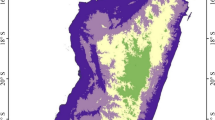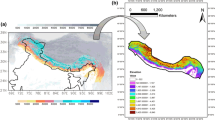Abstract
Using data archived in the Coordinated Enhanced Observing Period (CEOP) project, comparisons between field observations undertaken at Tongyu CEOP reference site in China and model output from year 2003 to 2004 have been implemented, and in particular, the time series and diurnal cycles of precipitation, near-surface temperature, air temperature, and latent and sensible heat fluxes are presented. The results show that the ability of the model simulations on the temperatures, such as air temperature and the surface temperature, is satisfactory compared with the simulations on the land surface heat fluxes and the precipitation at Tongyu site. In addition, the multi-model ensemble exhibits better results over all items in comparison with the observations. The differences of the precipitation at the interannual and the seasonal time scales between the model results and observations indicate that some of the models are able to reproduce the larger amount of precipitation in 2003 than that in 2004, which is consistent with the trend of the observations at Tongyu site even though the mean square errors of models output calculated from daily precipitation during year 2003 and 2004 are even greater than the daily amount of the precipitation. The poor skill in the quantitative simulation of the precipitation indicates that the deficiency of the models in simulating the surface heat fluxes may be closely related to the biases of the precipitation simulations. In terms of the seasonal time series of the precipitation, there is an increase during summer, accompanied by the same increased trend of the latent heat flux and the decreased trend of the sensible heat flux from the insitu observations.
Similar content being viewed by others
References
Beyrich, F., and W. Adam, 2004: A note on the use of CEOP reference site data for comparison with the output of global model: The Lindenberg example. CEOP Newsletter, 6, 6–7.
Bélair, S., R. Brown, J. Mailhot, B. Bilodeau, and L.-P. Crevier, 2003: Operational implementation of the ISBA land surface scheme in the Canadian regional weather forecast model. Part II: Cold season results. J. Hydrometeor., 4, 371–386.
Bosilovich, M. G., and R. Lawford, 2002: Report on the Coordinated Enhanced Observing Period (CEOP) international workshop. Bull. Amer. Meteor. Soc., 83, 1495–1499.
__, J. D. Radakovich, A. da Silva, R. Todling, and F. Verter, 2007: Skin temperature analysis and bias correction in a coupled landatmosphere data assimilation system. J. Meteor. Soc. Japan, 85A, 205–228.
__, J. Chen, F. R. Robertson, and R. F. Adler, 2009: Evaluation of global precipitation in reanalyses. J. Hydrometeor., 10, 912–934.
Chou, S. C., J. A. Marengo, C. P. Dereczynski, P. V. Waldheim, and A. O. Manzi, 2007: Comparison of CPTEC GCM and Eta model results with observational data from the Rondonia LBA reference site, Brazil. J. Meteor. Soc. Japan, 85A, 25–42.
Dorman, J. L., and P. J. Sellers, 1989: A global climatology of albedo, roughness length and stomatal resistance for atmospheric general circulation models as represented by the Simple Biosphere Model (SiB). J. Appl. Meteorol., 28, 833–855.
Fu, C., S. Wang, Z. Xiong, W. J. Gutowski, D.-K. Lee, J. L. McGregor, Y. Sato, H. Kato, J.-W. Kim, and M.-S. Suh, 2005: Regional climate model inter-comparison project for Asia. Bull. Amer. Meteor. Soc., 86, 257–266.
Kanamitsu, M., W. Ebisuzaki, J. Woollen, S.-K. Yang, J. Hnilo, M. Fiorino, and J. Potter, 2002a: NCEP/POE AMIP-II Reanalysis (R-2). Bull. Amer. Meteor. Soc., 83, 1631–1643
__, and Coauthors, 2002b: NCEP dynamical seasonal forecast system 2000. Bull. Amer. Meteor. Soc., 83, 1019–1037.
Koike, T., 2004: The Coordinated Enhanced Observing Period (CEOP): An initial step for integrated global water cycle observation. WMO Bull., 53, 115–121.
__, Y. Nakamura, I. Kaihotsu, G. Davaa, and N. Matsuura, 2003: AMSR-E soil moisture product validated at the CEOP Mongolia reference site. CEOP Newsletter, 7, 5.
Hirai, M., and T. Matsumura, 2004: A validation study of a new land surface scheme-with the CEOP EOP-1 reference site data set. CEOP Newsletter, 6, 3–5.
__, T. Sakashita, H. Kitagawa, T. Tsuyuki, M. Hosaka, and M. Oh’Izumi, 2007: Development and validation of a new land surface model for JMA’s Operational Global Model Using the CEOP Observation Dataset. J. Meteor. Soc. Japan, 85A, 1–24.
Lau, W. K. M., J. Matsumoto, M. Bollasina, and H. Berbery, 2004: Diurnal variability in the monsoon region: Preliminary results from the CEOP Inter-Monsoon Studies (CIMS). CEOP Newsletter, 5, 2–4.
Lin, H., G. Tu, W. Dong, C. Fu, and L. Shi, 2006: The diurnal and seasonal variations of water vapour and CO2 fluxes at a land surface in a semiarid region. Chinese J. Atomos. Sci., 30, 108–118.
Lu, C. -H., and K. Mitchell, 2004: Land surface processes simulated from the Noah LSM in the NCEP global model: A comparative study using he CEOP EOP-1 reference site observations. CEOP Newsletter, 5, 5–6.
Manabe, S., and R. T. Wetherald, 1987: Large scale changes of soil wetness induced by an increase in atmospheric carbon dioxide. J. Atomos. Sci., 44, 1211–1235.
Mesinger, F., and Coauthors, 2006: North American regional reanalysis. Bull. Amer. Meteor. Soc., 87, 343–360.
Milton, S. F., and P. Earnshaw, 2007: Evaluation of surface water and energy cycles in the Met Office global NWP model using CEOP data. J. Meteor. Soc. Japan, 85A, 43–72.
Wilson, M. F., and A. Henderson-Sellers, 1985: A global archive of land cover and soil data sets for use in general circulation climate models. Int. J. Climatol., 5, 119–143.
Yang, K., M. Rasmy, S. Rauniyar, and T. Koike, 2006: Inter-comparison of prediction skill of operatinal GCMs and a land data assimilation system. CEOP Newsletter, 10, 3–5.
__, and Coauthors, 2007: Initial CEOP-based review of the prediction skill of operational general circulation models and land surface models. J. Meteor. Soc. Japan, 85A, 99–116.
Author information
Authors and Affiliations
Corresponding author
Rights and permissions
About this article
Cite this article
Yao, Y., Guo, W. & Song, Y. Evaluating CEOP model performance with the observational data from Tongyu reference site, semi-arid region of China. Asia-Pacific J Atmos Sci 46, 475–481 (2010). https://doi.org/10.1007/s13143-010-0028-x
Received:
Revised:
Accepted:
Published:
Issue Date:
DOI: https://doi.org/10.1007/s13143-010-0028-x




